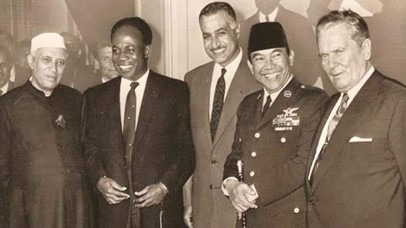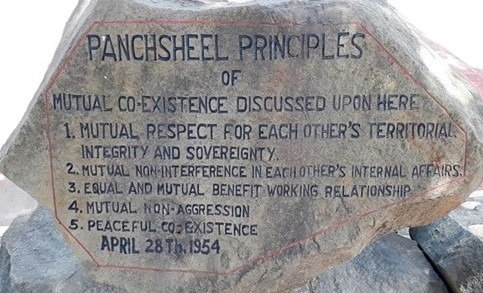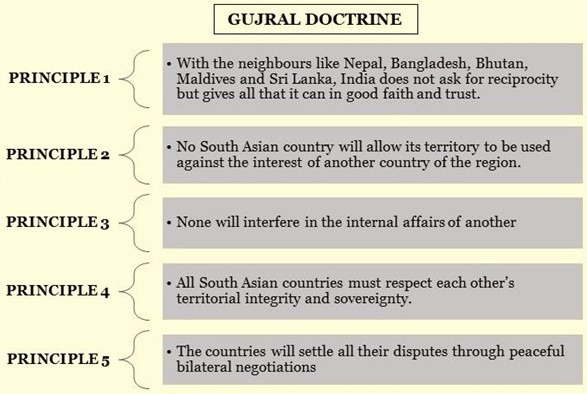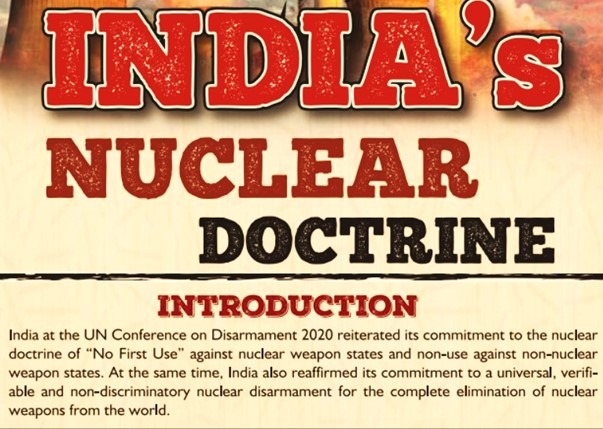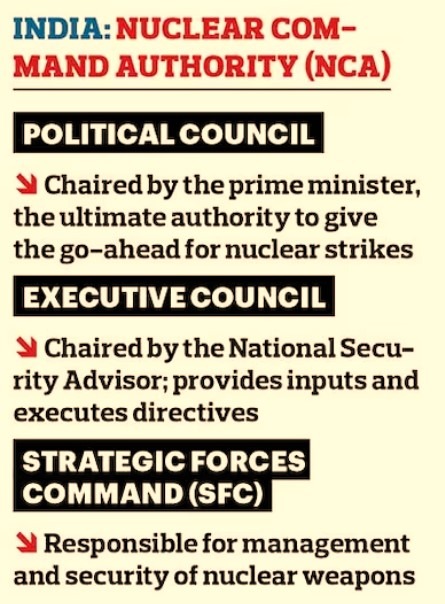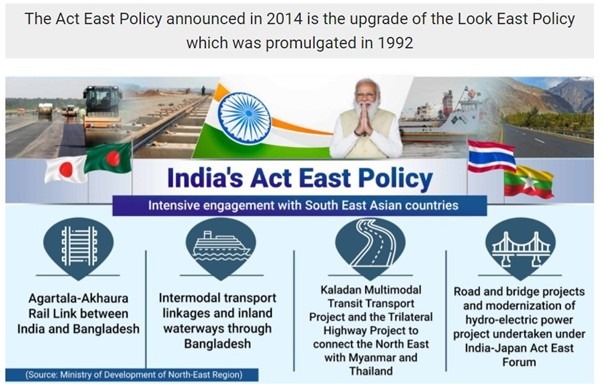Foreign Policy
Foreign Policy of India
The foreign policy of India is framed to govern its relations with other countries, aimed at promoting national interests. It is influenced by a multitude of factors, including geography, history, social structure, political organization, economic standing, military strength, public opinion, and leadership.
Principles of Indian Foreign Policy
1. Promotion of World Peace:
- India emphasizes international peace and security as central to its foreign policy. Article 51 of the Constitution instructs the state to encourage just relations between nations, promote international law, and resolve disputes via arbitration.
2. Anti-Colonialism:
- India’s foreign policy staunchly opposes colonialism and imperialism, advocating for the dismantling of colonial structures and supporting liberation movements in countries like Algeria, Tunisia, and Indonesia.
3. Anti-Racialism:
- The Indian stance against racial discrimination highlights its commitment to global justice and equality. India has taken a firm stand against apartheid in South Africa and supported movements for racial equality.
4. Non-Alignment:
- During the Cold War, India adopted a non-aligned position, choosing not to align with either the capitalist bloc led by the USA or the communist bloc led by the USSR. This policy reflects India’s commitment to independent foreign relations and maintaining friendly ties with all nations.
5. Panchsheel:
- The five principles of Panchsheel (mutual respect for territorial integrity, non-aggression, non-interference, equality, and peaceful coexistence), initially articulated in the Indo-China Treaty on Tibet in 1954, underscore India’s approach to international relations.
6. Afro-Asian Bias:
- India displays a particular affinity for Afro-Asian nations, promoting unity and cooperation among them. India seeks to amplify their voices in international forums and has historically supported their developmental efforts.
7. Links with Commonwealth:
- India remains a member of the Commonwealth, which serves as a platform for cooperation in various fields, while continuing to assert its sovereignty.
8. Support to the UNO:
- As a founding member of the United Nations, India supports the UN’s objectives and principles. It actively participates in peacekeeping missions and advocates against colonialism and imperialism at the UN level.
9. Disarmament:
- India supports global disarmament and opposes arms races, advocating for nuclear disarmament and emphasizing the importance of economic development over military spending. However, it has abstained from signing the Nuclear Non-Proliferation Treaty (NPT) and the Comprehensive Test Ban Treaty (CTBT) due to their perceived discriminatory nature.
India’s foreign policy is characterized by its commitment to peace, anti-colonialism, and inclusivity while remaining non-aligned in a polarized global environment. The principles derived from historical context, ideological stance, and a vision for cooperative international relations inform India’s diplomatic engagement, underlining its role as a significant player in global governance and regional stability.
Objectives of Indian Foreign Policy
India’s foreign policy is shaped by a variety of objectives designed to protect national interests while fostering global cooperation and stability. The principal aims of Indian foreign policy can be summarized as follows:
1. Protection of National Interests:
- Safeguarding India’s core national interests in a dynamic international landscape, fostering support and understanding within the global community.
2. Autonomy in Decision-Making:
- Ensuring the independence of India’s foreign policy decisions while playing a crucial role in establishing a stable, prosperous, and secure global order.
3. Combating Terrorism:
- Strengthening international efforts to combat terrorism, which poses a significant threat to global peace and security.
4. Economic Growth Support:
- Creating an international environment conducive to India’s rapid economic growth, including attracting investments, facilitating trade, accessing technology, and enhancing energy security.
5. Building Strategic Ties:
- Fostering closer relationships with P-5 countries (the five permanent members of the UN Security Council) while building strategic partnerships with major powers, including the USA, the EU, Japan, Russia, and China.
6. Improving Neighbourly Relations:
- Intensifying cooperation with neighboring countries through mutually beneficial partnerships, acknowledging each other’s legitimate concerns.
7. Economic Integration in SAARC:
- Working towards the realization of the South Asian Association for Regional Cooperation (SAARC)as a peaceful, economically integrated region engaged meaningfully with the global community.
8. Ending Cross-Border Terrorism:
- Ensuring that cross-border terrorism is curbed and dismantling the infrastructure supporting terrorism, particularly that originating from Pakistan.
9. Act East Policy:
- Advancing the Act Eastpolicy (formerly the Look East policy) to enhance substantive relations with ASEAN countries across various shared interests.
10. Strengthening Gulf Relations:
- Enhancing ties with Gulf countries, which host a significant Indian diaspora and are major suppliers of oil and gas, thus playing a vital economic role.
11. Regional Economic Cooperation:
- Leveraging economic growth through participation in regional organizations like BIMSTEC, Mekong-Ganga Cooperation, and trans-regional initiatives such as the IBSA (India, Brazil, South Africa) Initiativeand the Indian Ocean Rim Association for Regional Cooperation (IOR-ARC).
12. Collaboration with Global Groupings:
- Continuing engagement with regional formations such as the European Union (EU)and the G-20 to further India’s interests on the international stage.
13. Reforming the UN Security Council:
- Advocating for reforms in the UN Security Counciland promoting a multi-polar world order that respects principles of sovereignty and non-intervention.
14. Equitable Global Relations:
- Striving for fair and equitable relationships between the developed and developing worlds in political, economic, and technological domains.
15. Nuclear Disarmament:
- Working towards global nuclear disarmament within a time-bound framework to foster peace and security.
16. Engagement with the Indian Diaspora:
- Actively interacting with the Indian diaspora to strengthen their connection with India and recognize their critical role in enhancing India’s international relations.
These objectives collectively represent India’s aspirations to engage meaningfully and effectively on the global stage while securing its national interests. Through its foreign policy framework, India aims to promote peace, prosperity, and cooperative international relationships, reflecting its values and commitments to the global community.
Gujral Doctrine of India
The Gujral Doctrine is a significant aspect of India’s foreign policy established during 1996 under the tenure of I.K. Gujral, then Foreign Minister in the Deve Gowda Government. This doctrine emphasizes India’s role as the largest country in South Asia and advocates for a more accommodating approach towards its smaller neighbors.
Key Principles of the Gujral Doctrine
The Gujral Doctrine is encapsulated in five primary principles:
1. Unilateral Concessions:
- India should extend goodwill and unilateral concessions to smaller neighboring countries like Bangladesh, Bhutan, Maldives, Nepal, and Sri Lanka without expecting reciprocity.
2. Territorial Integrity:
- No South Asian country should allow its territory to be used in any way that threatens the interests of another country in the region.
3. Non-Interference:
- Countries should refrain from interfering in each other’s internal affairs, promoting autonomy and respect for sovereignty.
4. Mutual Respect:
- All South Asian nations should recognize and respect each other’s territorial integrity and sovereignty.
5. Peaceful Dispute Resolution:
- Disputes among South Asian countries should be settled through peaceful bilateral negotiations rather than conflict.
Gujral himself stated that the rationale behind the doctrine was to maintain “total peace” with immediate neighbors in order to effectively counter the influence of hostile neighbors like Pakistan and China.
Nuclear Doctrine of India
India formally adopted its nuclear doctrine in 2003, establishing a framework for its nuclear posture and strategy. The doctrine outlines key features aimed at maintaining national security while deterring aggression.
Salient Features of India’s Nuclear Doctrine
1. Credible Minimum Deterrent:
- India aims to maintain a credible minimum nuclear deterrent capability to dissuade aggression.
2. No First Use (NFU):
- India adopts a “No First Use” policy, stating that nuclear weapons will only be used in retaliation against a nuclear attack on Indian territory or its forces.
3. Massive Retaliation:
- Any nuclear retaliation to a first strike will be significant and intended to inflict unacceptable damage on the aggressor.
4. Civilian Leadership Approval:
- The use of nuclear weapons can only be authorized by civilian political leadership through the Nuclear Command Authority.
5. Non-Use Against Non-Nuclear States:
- India commits to not using nuclear weapons against non-nuclear weapon states.
6. Response to Chemical/Biological Attacks:
- In the event of a major attack involving biological or chemical weapons against India, India retains the option to respond with nuclear weapons.
7. Strict Export Controls:
- India imposes strict controls over the export of nuclear and missile-related materials and technologies, participating in negotiations for the Fissile Material Cutoff Treatyand adhering to a moratorium on nuclear tests.
8. Commitment to Disarmament:
- India maintains a commitment to achieving a nuclear-weapon-free world through global and verifiable nuclear disarmament.
Nuclear Command Authority (NCA)
The Nuclear Command Authority consists of:
- Political Council: Chaired by the Prime Minister, this body is the sole authority that can authorize the use of nuclear weapons.
- Executive Council: Chaired by the National Security Advisor, it provides inputs for decision-making and executes directives from the Political Council.
The Cabinet Committee on Security (CCS) regularly reviews India’s nuclear doctrine, assessing command and control structures as well as operational readiness. It has approved the appointment of a Commander-in-Chief of the Strategic Forces Command to oversee and manage all strategic nuclear forces.
Both the Gujral Doctrine and India’s nuclear doctrine reflect the country’s strategic approach to foreign relations and national defense, rooted in principles of cooperation, respect for sovereignty, and the maintenance of peace. These frameworks illustrate India’s commitment to regional stability and its calculated nuclear strategy, positioning itself as a responsible power on the global stage.
Connect Central Asia Policy of India
Launched in 2012, India’s Connect Central Asia Policy aims to strengthen and expand bilateral relations with Central Asian countries, namely Kazakhstan, Kyrgyzstan, Tajikistan, Turkmenistan, and Uzbekistan. This policy seeks to enhance political, security, economic, and cultural ties in a region of strategic importance to India.
Key Features of the Policy
1. Strengthening Political Relations:
- India will enhance political ties through high-level exchanges and interactions within bilateral and multilateral forums.
2. Strategic and Security Cooperation:
- The policy emphasizes military training, joint research, and counter-terrorism coordination, building on existing strategic partnerships with Central Asian nations. Close consultations regarding Afghanistan are also prioritized.
3. Multilateral Engagement:
- India aims to increase its multilateral involvement using the synergy of joint efforts through organizations such as the Shanghai Cooperation Organization (SCO), the Eurasian Economic Community (EEC), and the Customs Union. Proposals for a Comprehensive Economic Cooperation Agreement(CECA) have been made to integrate India’s markets with the Eurasian region.
4. Energy and Natural Resources Cooperation:
- Central Asia is rich in energy and natural resources, and India seeks to collaborate on agricultural production and resource management to enhance economic ties.
5. Medical Cooperation:
- India plans to set up civil hospitals and clinics in Central Asia to provide medical services, thus enhancing health collaboration.
6. Higher Education Initiatives:
- India aims to assist in establishing a Central Asian Universityin Bishkek to provide world-class education in fields such as IT, management, philosophy, and languages, capitalizing on its cost-effective education system.
7. Central Asian e-Network:
- The initiative will create a connectivity platform for tele-education and tele-medicine among Central Asian states, further enhancing collaboration in these crucial sectors.
8. Infrastructure Development:
- Indian companies are encouraged to participate in infrastructure projects, particularly in the construction sector, leveraging abundant local resources like iron ore, coal, and electricity.
9. Land Connectivity:
- India has revitalized the International North-South Transport Corridor (INSTC), aiming to improve trade routes and connections with Central Asia and beyond.
10. Banking Infrastructure Development:
- Efforts are being made to improve banking infrastructure in Central Asia to facilitate trade and investment opportunities. Indian banks may expand their presence if the policy environment is favorable.
11. Enhancing Air Connectivity:
- Initiatives to improve air travel between India and Central Asian countries are being pursued, capitalizing on the burgeoning outbound travel market from India and promoting tourism.
12. People-to-People Connections:
- Strengthening ties through cultural and educational exchanges is emphasized, with a focus on regular exchanges among youths and scholars to foster mutual understanding.
13. Cultural and Interfaith Dialogues:
- Emphasizing cultural diplomacy, the policy encourages mutual cultural engagement and interfaith dialogue to reinforce harmonious relations.
India’s “Connect Central Asia” policy reflects a holistic approach to diplomatic relations, recognizing the importance of multiple lines of engagement—political, economic, cultural, and security. As geopolitical dynamics continue to evolve, enhancing ties with Central Asian nations remains a strategic priority for India, aligning with its broader interests in Eurasia and ensuring sustained partnerships in the region.
Act East Policy of India
In 2014, the Indian government under Prime Minister Narendra Modi redefined and upgraded the previously established Look East Policy, shifting its focus to a more proactive Act East Policy. Originally initiated by Prime Minister P.V. Narasimha Rao in 1992, the policy aims to deepen India’s engagement with the Asia-Pacific region, recognizing its strategic importance for India’s economic and geopolitical interests.
Key Features of India’s Act East Policy
1. Extended Neighbourhood Focus:
- The Act East Policy emphasizes India’s relationship with its extended neighborhood in the Asia-Pacific. Initially an economic initiative, it has broadened to encompass political, strategic, and cultural dimensions, establishing institutional mechanisms for dialogue and cooperation.
2. Strategic Partnerships:
- India upgraded its relationships to strategic partnerships with several countries, including Indonesia, Vietnam, Malaysia, Japan, the Republic of Korea, Australia, Singapore, and the Association of Southeast Asian Nations (ASEAN), reinforcing ties across the Asia-Pacific region.
3. Active Engagement in Regional Fora:
- Beyond ASEAN, India is actively participating in several regional forums such as the ASEAN Regional Forum (ARF), East Asia Summit (EAS), Bay of Bengal Initiative for Multi-Sectoral Technical and Economic Cooperation (BIMSTEC), Asia Cooperation Dialogue (ACD), Mekong Ganga Cooperation (MGC), and the Indian Ocean Rim Association (IORA).
4. Domestic and Regional Cooperation:
- The policy integrates India-ASEAN cooperation into domestic initiatives such as infrastructure, manufacturing, trade, skill development, urban renewal, and the Make in India Connectivity projects aim for comprehensive regional integration, enhancing collaboration in areas such as technology and cultural exchanges.
5. Objective of Economic Cooperation:
- The primary goal is to promote economic cooperation, cultural ties, and strategic relationships with Asia-Pacific nations while providing enhanced connectivity to the northeastern states of India, like Arunachal Pradesh.
6. Focus on North East India:
- The North East region of India is emphasized in the Act East Policy, creating a direct link between this area and ASEAN countries, fostering trade, culture, and people-to-people contacts.
7. Strengthened Connectivity Plans:
- Efforts are underway to enhance connectivity between the North East and ASEAN through physical infrastructure improvements and cultural exchanges.
8. Civilizational Links:
- The policy looks to revitalize and strengthen Buddhist and Hindu links to establish deeper connections with regional neighbors.
9. Infrastructure and Transportation Development:
- A coherent strategy is being developed to improve transport infrastructure, enhance airline connectivity, and foster academic and cultural connections between India and ASEAN.
10. Economic Engagement with ASEAN:
- Economic cooperation with ASEAN has been prioritized, including the ASEAN-India Agreement on Trade in Services and Investmentsthat came into effect for India and seven ASEAN countries on July 1, 2015.
11. Strategic Security Cooperation:
- The policy has led to closer cooperation on security issues with key partners, focusing on combating terrorism, promoting peace and stability in the region, and enhancing maritime security in accordance with international laws and norms.
Objectives of ‘Act East Policy’:
- Promote economic cooperation, cultural ties, and develop a strategic relationship with countries in the Asia-Pacific region through continuous engagement at regional, bilateral, and multilateral levels.
- To increase the interaction of the North-Eastern Indian states with other neighboring countries.
- To find out the alternatives of the traditional business partnerslike; more focus on the Pacific countries in addition to the South East Asian countries.
- To curb the increasing impact of China in the ASEAN region.
- Experts say that under the “Act East Policy” the government is relying on the 3 C’s (Culture, Connectivity, and Commerce) to develop better relations with ASEAN nations.
Significance:
- Under the Act East Policy (AEP), the India-Japan strategic partnership has been liftedto an entirely new level, underscoring the importance of Indo- Pacific cooperation.
- India believes in an Indo-Pacific that is free, open and inclusive, and one that is founded upon a cooperative and collaborative rules-based order.
- ASEAN’scentrality remains the abiding contemporary characteristic of the Indo-Pacific at the regional level.
- India has placed the ‘Indo-Pacific’ at the heart of its engagementwith the countries of South, Southeast and East Asia. Gradually, Act ‘East’ is getting transformed into Act ‘Indo-Pacific’.
India’s initiatives to strengthen the Act East Policy
Includes
- Agartala-Akhaura Rail Link between India and Bangladesh
- Intermodal transport linkages and inland waterways through Bangladesh.
- Kaladan Multimodal Transit Transport Project –
- Kaladan transit project in Myanmar’s Rakhine state is seen as crucial to improving connectivity with the landlocked northeastern states
- The Trilateral Highway Project connecting the North East with Myanmar and Thailand.
- Under India-Japan Act East Forum, projects such as Road and Bridges and modernization of Hydro-electric power projects have been undertaken.
- Among other initiatives assistance has been extended in the form of medicines/medical supplies to ASEAN countries during the pandemic.
- India is also implementing Quick Impact Projects in Cambodia, Laos, Myanmar and Vietnam to provide development assistance to grass-root level communities in the fields of education, water resources, health etc.
Other initiatives
Mahabahu-Brahmaputra inland waterway project-
- The launch of Mahabahu-Brahmaputra will be marked by the inauguration of the three Ro-pax vessel operations between Neamati-Majuli Island, North Guwahati-South Guwahati and Dhubri-Hatsingimari.
Dhubri Phulbari bridge
- Foundation stone for a 19-km-long four-lane Dhubri Phulbari bridge over the Brahmaputra
- It will be India’s longest bridge over a river that connects Dhubri in Assam and Phulbari in Meghalaya, to be constructed at the cost of Rs 5,000 crore.
National Bamboo Mission
- The Mission envisages promoting holistic growth of the bamboo sector by adopting an area-based, regionally differentiated strategy.
- The aim is to increase the area under bamboo cultivation and marketing.
Bru or Reang resettlement
- The agreement has been signed between the Government of India, Government of Tripura and Mizoram and Bru community representatives in New Delhi on 16th January 2020 to put an end to the 23 years old Bru refugee crisis.
Digital North East Vision 2022
- It was launched by the Union Minister for Electronics & IT in Guwahati.
- The Vision Document emphasizes leveraging digital technologies to transform the lives of people of the northeast and enhance the ease of living.
NITI Forum for North East
- Focussed attention on the development of NER:
- The forum examines various proposals both at the Central and the State levels and prepares plans for the speedy development of the North Eastern Region.
- The Forum proposed that the development projects in the NER would be based on the concept of “HIRA” (Highways, Inland Waterways, Railways and Airways)
The Act East Policy represents a significant shift in India’s approach to foreign relations, emphasizing proactive engagement with Southeast Asia and the broader Asia-Pacific region. Its multifaceted strategy encompasses economic cooperation, cultural connections, and security interests, aiming to position India as a vital player in regional and global affairs while addressing the strategic importance of its northeastern states. Through this policy, India seeks to enhance its influence and foster a cooperative environment in a rapidly changing geopolitical landscape.Top of Form

